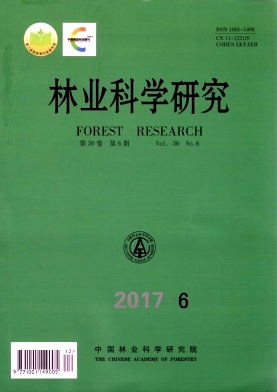-
印度黄檀(Dalbergia sissoo Roxb.)属蝶形花科(Fabaceae)黄檀属(Dalbergia)多用途速生木本植物, 主要分布于印度、巴基斯坦和尼泊尔等国家[1]。印度黄檀木材具有优良的坚固性和弹性,可用于制作家具、橱柜、乐器和胶合板[2];石雷等[3-5]对印度黄檀木材解剖结构及理化性质进行了研究,结果显示木材的解剖结构径向变异趋势明显,木材PH值为5.39,生长轮年龄与各解剖参数和结晶度相关性显著,印度黄檀的综合品质系数为2 309×105Pa,为高等级用材。这些性质均表明印度黄檀是优秀的用材,具有很高的经济价值,是一种值得推广的珍贵树种。石雷等在对引进的印度黄檀适生性气候因子研究显示,印度黄檀适宜在年平均气温为20~27℃, 极端低温高于0℃, 极端高温为39~43℃, 以及年平均降水量高于600 mm的地区推广种植,特别是云南省干热河谷地区[6]。刘絮子等[7]通过对气候条件分析认为,云南省适宜种植印度黄檀的土地面积占32.5%,最适宜面积占0.7%,较适宜面积占7.4%。
印度黄檀自1999年从国外引种到国内,迅速得到推广,现在广东省、海南省、福建省、云南省等均有大量种植。印度黄檀一般通过种子进行有性繁殖[8]。国内虽有组织培养研究[9],但在国内未进行过印度黄檀优良品种的选育研究,因此,国内大面积种植的均为种子苗。调查发现,种子苗分化较为严重,长势参差不齐,株高及胸径差异较大,存在较多弯扭木,这些因素极大影响了林分质量。中国林科院资源昆虫研究所自2000年起,从国外引进了4个印度黄檀种源,种植11年后观测发现,不同种源种子苗中均存在少量生长快、树干挺直、株高及胸径具明显优势的植株,若对这些优株进行无性系测定,将有可能进一步筛选并培育出无性系新品种,为印度黄檀高效优质林分的建设提供优质种苗。为此,本研究对从4个国外引进的印度黄檀种源中选出的20棵优株,并以此使用嫁接手段繁殖20个无性系,对20个2年生无性系嫁接苗木胸径和株高进行比较分析,试图从中选出优良无性系,为进一步培育无性系新品种提供依据。
HTML
-
作者于2000年、2002年、2004年和2006年分别从尼泊尔、印度和洪都拉斯3个国家引进了4批印度黄檀种源,分别将4种种源编号为N0、N2、I4和H6,引进的当年7—8月进行造林,均种植于中国林业科学研究院资源昆虫研究所元江热区试验站(云南省玉溪市元江哈尼族彝族傣族自治县)。2007年1月9日,对4个种源的印度黄檀人工林的株高和胸径进行测量,N0、N2、I4和H6分别测定了38、106、20和33棵树。然后,选取较为优秀的印度黄檀作为无性繁殖的优株,以平均株高和胸径为标准,选取株高和胸径大于或者约等于平均值的130%,作为优株,共选择了20棵优株,编号1~20,进行无性系繁殖。由于未能收集到N2、I4和H6种源的种子,只收集到了N0种源的种子,因此以N0种源种子进行培育实生苗作为对照。
-
种植无性系苗木样地位于云南省元江哈尼族彝族傣族自治县中国林业科学研究院资源昆虫研究所热区试验站内。在元江热区试验站选择1块向阳的山丘,通过推土机将山丘自上而下,挖成类似于梯田的条状台地,每块台地相距高度为120 cm左右,并在台地用水管布满喷灌设施,便于给植株施水。同时,利用挖掘机在每1块台地中挖好用于种植印度黄檀的深坑,每个深坑相距100 cm左右,每个深坑深50 cm左右,直径80 cm左右。
-
将20棵印度黄檀优株,通过嫁接的方式,分别繁殖2代,于第3代将选择的20个无性系进行编号(1~20号),通过随机区组的方式,于2015年7月20日种植在元江热区试验站上。设置3个小区,每小区种植127棵树,即每个无性系分别种植6棵树,实生苗种植7棵树。因此,3个小区,每个无性系各种植了18棵树,实生苗种植了21棵树。种植完成后,对根部进行浇水作业。于种植后第3天,在根部撒上生根粉,并同时进行浇水作业。之后,每隔3~5天进行1次喷灌浇水作业,每隔3个月进行1次施肥作业。于2016年11月25日进行株高和胸径数据的采集。
-
不同无性系间的株高、胸径的差异,采用One-Way ANOVA进行分析,差异达到显著水平,则采用Duncan’s多重比较检验组间差异。优株和无性系的相对母株平均值和对照生长参数的生长增量,优株使用株高和胸径占母株平均值的百分比率表示,无性系使用株高和胸径占对照的百分比率表示。所有数据分析均在SPSS和EXCELL中进行。
1.1. 印度黄檀优株选择
1.2. 无性系种植样地选择与处理
1.3. 无性系种植、水肥管理及生长参数采集
1.4. 数据分析
-
4种种源印度黄檀母株生长参数如表 1,4种种源印度黄檀母株的株高和胸径变异系数均超过了20%。N0种源株高变异系数最高,达到了34.76%;N2种源胸径变异系数最高,为37.90%。因此,引进种源印度黄檀实生苗变异较大,不适宜直接用于印度黄檀造林以及优良品种的选育(表 1)。
种源Provenance 数量Number 株高Height /m 胸径DBH /cm 平均值Mean 变异幅度
Variation range变异系数VC 平均值Mean 变异幅度
Variation range变异系数VC N0 38 10.7 2.8~17.0 34.76 11.7 2.3~18.0 29.18 N2 106 4.9 1.8~11.5 32.90 4.0 1.1~8.2 37.90 I4 20 7.2 5.0~11.1 21.50 5.7 4.0~9.2 24.40 H6 33 7.1 4.2~11.9 30.70 7.9 3.3~16.7 50.70 Table 1. The growth situation of four provenances Dalbergia sissoo
以株高或者胸径平均值的130%的数值,为参考标准选择优株。N0种源参考标准为株高13.91 m,胸径15.21 cm;N2为株高6.37 m,胸径5.2 cm;I4为株高9.36 m,胸径为7.41 cm;H6为株高9.23 m,胸径10.27 cm(表 2)。选择的优株,优先满足株高和胸径均大于参考标准,其次选择株高或者胸径大于参考标准,而另一生长参数在参考标准附近。因此,通过比对每1棵母株的生长参数大小,选择出了20个优株,如表 1所示。N0种源选择了8棵优株,株高为14.5~17.0 m,胸径为13.5~18.0 cm,编号为1~8;N2种源选择了6棵优株,株高为7.2~11.5 m,胸径为6.9~8.2 cm,编号为9~14;I4种源选择了3棵优株,株高为9.5~11.1m,胸径为7.8~9.2 cm,编号为15~17;H6种源也选择了3棵优株,株高为10.0~11.9m,胸径为14.0~16.7cm,编号为18~20(表 3)。共选择了20棵优株进行无性系繁殖。
种源Provenance 株高Height /m 胸径DBH /cm N0 13.91 15.21 N2 6.37 5.20 I4 9.36 7.41 H6 9.23 10.27 Table 2. The standard for superior plant selection of four provenances Dalbergia sissoo
优株
Superior plant株高
Height/m胸径
DBH/cm优株
Superior plant株高
Height/m胸径
DBH/cm1 16.5 18.0 11 11.5 8.2 2 14.8 15.0 12 7.9 7.0 3 14.8 15.5 13 9.5 7.7 4 14.5 14.0 14 7.2 6.9 5 15.0 15.0 15 9.8 7.8 6 14.7 13.5 16 9.5 8.6 7 17.0 16.0 17 11.1 9.2 8 15.0 15.0 18 11.9 16.7 9 8.5 8.0 19 10.0 14.7 10 8.9 7.8 20 10.7 14.0 Table 3. Growth parameters of superior plants of Dalbergia sissoo
-
通过方差分析,结果显示20个无性系间的株高和胸径的差异,均达到了极显著的水平,具有较大的选择潜力(表 4)。对20个无性系株高和胸径进行Duncan’s多重比较,发现无性系9、10和12号表现出株高显著最高,其次为20和19号无性系(表 5);9和10号胸径也表现出显著最大,其次为20、19和18号,而12号与9、10、20、19和18号无显著差异,但要好于其它无性系(表 5);无性系9和10号株高变异系数为11.73%和11.55%,远远小于其它无性系,其胸径变异系数分别为18.53%和17.68%,也小于大多数无性系,其次为20、19和12号,其株高和胸径变异系数相较于其它无性系也比较小;不过18号无性系胸径变异系数较大,为28.51%。综上,无性系9和10号表现最好,优选为优良无性系。
生长指标
Growth index变差来源
Source平方和
Quadratic sum自由度DF 均方和
Mean sum of squareF 显著性
Significance株高Height 组间Among groups 65.551 20 3.278 6.436 <0.000 1 组内In group 208.788 410 0.509 总数Total 274.340 430 胸径DBH 组间Among groups 30.266 20 1.513 5.574 <0.000 1 组内In group 111.306 410 0.271 总数Total 141.572 430 Table 4. Variance analysis for growth of Dalbergia sissoo clones
无性系
Clone株高
Height /m株高变异系
数VC /%胸径
DBH /cm胸径变异系数
VC /%对照 2.88±0.08e 25.90 1.61±0.06efg 35.48 1 2.40±0.21f 35.56 1.36±0.12g 36.62 2 3.16±0.22cde 29.29 1.81±0.15def 34.77 3 3.20±0.26cde 31.96 1.74±0.15defg 34.27 4 3.19±0.17cde 21.53 1.84±0.15def 34.46 5 3.06±0.20de 27.00 1.94±0.15bcde 31.85 6 3.25±0.13bcde 16.45 1.72±0.09defg 20.71 7 2.98±0.15e 20.37 1.58±0.11efg 28.98 8 3.16±0.18cde 23.12 1.85±0.12cdef 26.25 9 3.93±0.11a 11.73 2.35±0.10a 18.53 10 4.01±0.11a 11.55 2.31±0.10a 17.68 11 3.03±0.22e 30.29 1.74±0.15defg 36.06 12 3.96±0.16a 16.69 2.09±0.10abcd 20.73 13 3.13±0.21cde 27.10 1.49±0.14fg 38.48 14 3.35±0.12bcde 14.76 1.85±0.11cdef 25.40 15 3.31±0.17bcde 21.17 1.85±0.12cdef 27.33 16 3.35±0.14bcde 17.30 1.85±0.08cdef 18.07 17 3.02±0.15e 21.59 1.60±0.10efg 27.54 18 3.64±0.16abc 18.52 2.13±0.14abcd 28.51 19 3.62±0.13abcd 15.19 2.24±0.09abc 16.51 20 3.76±0.15ab 16.71 2.25±0.12ab 22.98 同一列中不同小写字母表示不同无性系间数据差异水平达到P<0.05。Different lowercase letters in the same row means the significant level was at P<0.05. Table 5. The height, DBH, and coefficient variation of Dalbergia sissoo clones
-
无性系9号和10号在所有无性系中,株高分别达到了CK的136.46%和139.24%,胸径则分别达到了145.96%和143.48%,为所有无性系中最大;对于优株9号和10号,其株高和胸径均超过了N2种源母株平均株高和胸径的170%。其次为20号无性系,株高和胸径分别达到了CK的130.56%和139.75%,而20号优株株高和胸径也显著高于母株平均值的130%,分别为150.70%和177.22%。其它无性系,株高和胸径均未同时满足大于CK的130%,不过12号无性系株高超过了CK的130%,胸径则为CK的129.81;而18和19号无性系胸径均超过了CK的130%,而株高要小于CK的130%,均低于CK株高的127%。因此,9和10号无性系,可以选择为优良无性系,其次为20号,再次为12号。
编号Number 优株Superior plant 无性系Clone 株高
Height胸径
DBH株高
Height胸径
DBHCK(母株平均值)
CK(Mean of mother plants)100 100 100 100 1 154.21 153.85 83.33 84.47 2 138.32 128.21 109.72 112.42 3 138.32 132.48 111.11 108.07 4 135.51 119.66 110.76 114.29 5 140.19 128.21 106.25 120.50 6 137.38 115.38 112.85 106.83 7 158.88 136.75 103.47 98.14 8 140.19 128.21 109.72 114.91 9 173.47 200.00 136.46 145.96 10 181.63 195.00 139.24 143.48 11 234.69 205.00 105.21 108.07 12 161.22 175.00 137.50 129.81 13 193.88 192.50 108.68 92.55 14 146.94 172.50 116.32 114.91 15 136.11 136.84 114.93 114.91 16 131.94 150.88 116.32 114.91 17 154.17 161.40 104.86 99.38 18 167.61 211.39 126.39 132.30 19 140.85 186.08 125.69 139.13 20 150.70 177.22 130.56 139.75 Table 6. The growth increment (mean) of superior plant and clones compared with mother plants and seedling, respectively
%
2.1. 4种种源印度黄檀优株选择
2.2. 印度黄檀无性系测定
2.3. 母株与无性系对比选择
-
本研究通过测定印度黄檀母株株高和胸径,同时比较各母株的株高和胸径,选择约等于或大于株高和胸径平均值的130%的母株,作为优株。因此本研究共筛选出了20棵母株,作为繁殖无性系的优株。研究认为,优株的筛选,主要通过每个性状的比较,选择各个性状优良的母株[10-14],对于作为具有重要经济价值的用材树种印度黄檀而言,株高和胸径的大小能够表现出印度黄檀的优良性。因此,挑选出株高较高、胸径较大的母株,可以作为优株。
20个无性系生长量间存在显著差异,具有较大的选择潜力,通过多重比较分析,无性系9和10号株高和胸径显著最大,且变异系数相对较小,可作为优良无性系;其次20、19和12号表现较好,可作为备选优良无性系。研究认为,可以通过林木苗期相关性状的筛选,缩短林木育种周期并可加快育种进程[15]。本研究通过比较2年生印度黄檀无性系苗木的生长参数(株高和胸径),以此达到快速筛选出优良无性系的目的。通过对苗木性状进行逐一比对、选择和改进,以此达到选择优良无性系[16]。对于用材林木优良无性系测定与选择,均采用比较株高、胸径和地径的方法进行,通过这3个指标进行其它参数的转换,从而筛选出优秀的无性系,为选育优良的用材品种提供理论基础[17-20]。本研究筛选出的2个印度黄檀优良无性系,株高和胸径的变异系数均小于母株。
印度黄檀9和10号无性系株高和胸径均大于CK的130%,9和10号优株的株高和胸径也超过了母株平均值的170%,因此9号和10号可以确定为优良无性系。且据田间观察,9和10号无性系,树形比较好,树干较直,胸径较粗,无明显的弯扭情况产生,远远好于其它无性系,其株高和胸径变异系数也远远小于其它无性系。而其它无性系,均有弯扭严重、树形较矮较细的情况出现,甚至有落叶直接死亡的情况产生。因此,本研究筛选出的优良无性系,能够保证比其它无性系和对照优秀,可以用于印度黄檀苗木的生产。本研究在国内第一次测定印度黄檀无性系,并筛选优良无性系。
-
本研究通过对4个种源的印度黄檀母株株高和胸径的测定,选择株高和胸径约等于或者大于平均值130%的母株作为优株,共筛选出20棵优株;然后通过嫁接成苗并移栽,测定2年生印度黄檀无性系,对20个无性系株高和胸径之间比较分析,同时进行生长增量分析,筛选出2个优良无性系,9和10号无性系,为进一步培育优良无性系新品种提供理论依据。





 DownLoad:
DownLoad: